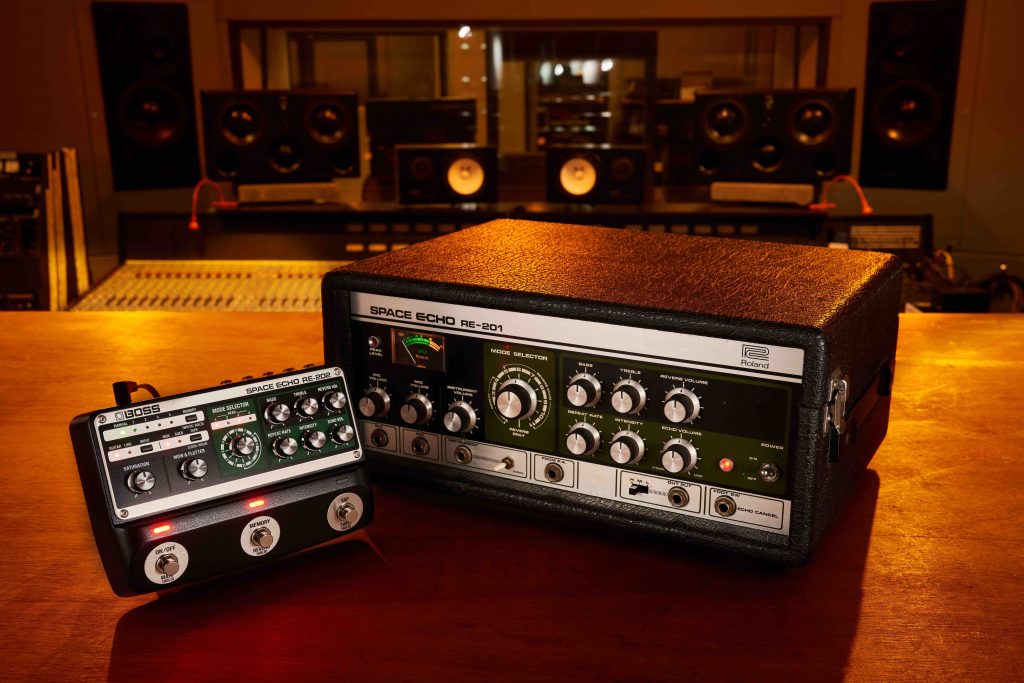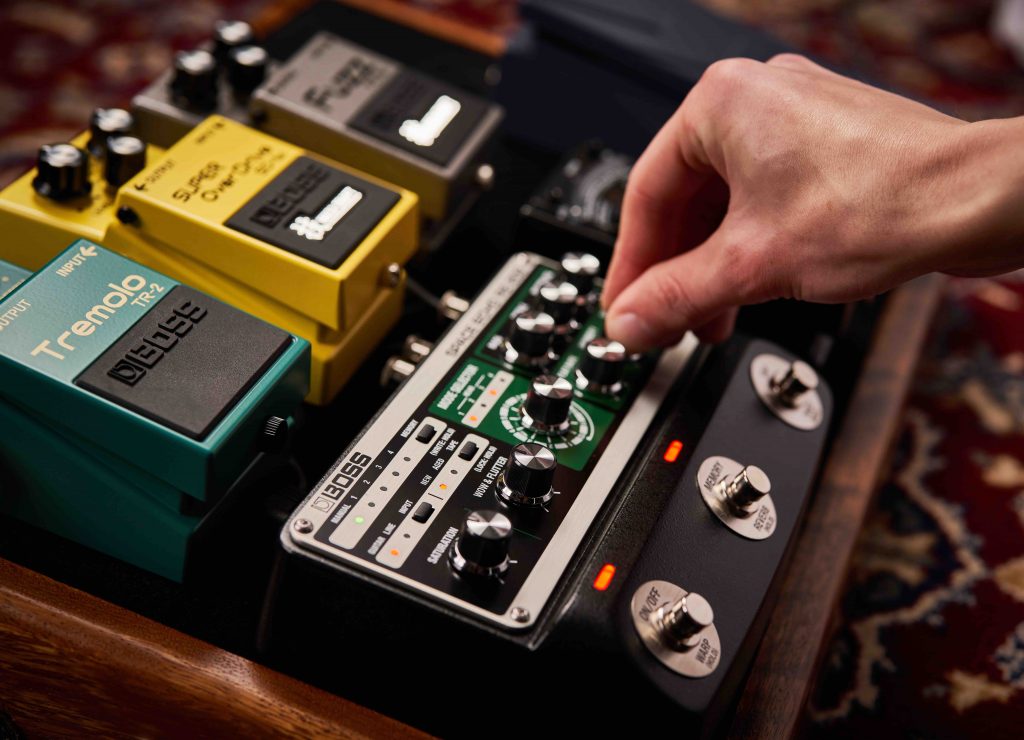Behind the RE-202 and RE-2 is a new modeling approach. These pedals offer extremely accurate emulations of the original RE-201 Space Echo attributes. In addition, both pedals have the ability to take things a little further. BOSS engineers developed these advanced modeling algorithms specifically for this project. They do not appear in any previous BOSS multi-effect products.
The Magic of Tape
Tape-based echo units rely on a loop of tape that passes a record head followed by one or more replay heads. The tape then passes an erase head before it reaches the record head again. The magnetic properties of tape cause it to compress and distort the sound at higher recording levels. Repeated use of the same piece of tape results in a loss of high end performance.

Artifacts and Overdrive
There are also small pitch modulation artifacts which we call wow and flutter. These relate to factors such as a misshapen rubber or other imperfections in the tape transport mechanism. To recreate the original sound, engineers must emulate these factors along with the RE-201’s preamp section. The latter had a unique tonal signature and distorted in a unique way when deliberately overdriven. You can try this for yourself. Increasing the input gain firstly brings in some warm distortion. As you push harder, the sound becomes more aggressive.
"The RE-201 preamp section had a unique tonal signature and distorted in a unique way when deliberately overdriven."
Classic Tones
Try exploring the various rhythmic delays you can set up using the Mode control to select different head combinations. That’s the key to nailing those old Shadows or Ventures guitar sounds. It’s also a great way to recreate many of David Gilmour’s signature sounds, which sometimes used a dotted eighth note timing. Dial in a little reverb to add a sense of distance to the repeats.
The Wow Factor
The RE-201 was a robust, well-engineered unit and only exhibited a relatively small amount of wow and flutter. Still, the BOSS engineers decided to give their new Space Echo pedals a separate control for wow and flutter amount. It features a wide range to emulate the chorus-like warble of some vintage tape echo units. When one adds wow and flutter to the echoes of a guitar or vocal part, the resulting pitch modulation gives the delays an attractive complexity.

Complex Repeats
As the signal from the heads gets fed back to the input to create repeats, it also loses a little more high end. It also accumulates more analog tape degradation, which makes the repeats sound like they’re melting into the distance as they die off. Adjust this using the Intensity control. Again, BOSS modeled this complex signal degradation precisely. This captures the unique way RE-201 delays gradually blur and fade as they repeat. Try adjusting the EQ controls to see how the character of the repeats changes.
During the feedback process, the effects of wow and flutter become cumulative. This helps to further degrade the repeats. The more pronounced the modulation, the more vibrato gets added to the repeats. When these repeats combine with the dry sound and repeats, the unit produces a multi-layered chorus-like effect. Turn up the Intensity control to hear this. As with the original, when the Intensity control gets turned beyond a certain point, the delays build in intensity. The result is self-oscillation.
"As with the original Space Echo, when the Intensity control gets turned beyond a certain point, the delays build in intensity. The result is self-oscillation."
Lo-fi Sounds
Try going further and dialing in excessive wow and flutter. This produces a lo-fi effect that is very much in fashion. When you apply the sounds to sample loops and drum parts, it creates the effect of a warped vinyl record, which is quite hypnotic. That is one area where a modeled emulation offers unique benefits. You can dial in as little or as much wow and flutter, or other imperfection, as needed for any particular sonic task. Given the popularity of lo-fi sounds over the past few years, this less-pristine end of the RE-202’s delay spectrum has many applications.
A Range of Delays
The RE-202 also has a separate control to adjust the amount of saturation, which adds a warm type of distortion. There is also a useful Tape Age switch. By combining these variables with the onboard EQ, one can conjure up a wide range of delay sounds. These range from bright and clean to seriously dark and murky. In other words, you can go from the sound of a brand new RE-201 Space Echo to a worn-out vintage tape echo and all points in-between.

No Limits
Rather than stick to the limitations of the original RE-201, a mono device, the new Space Echo pedals have stereo ins and outs. They also boast twice the maximum delay time of the original. Moreover, the RE-202 adds an extra head and programmability. It stores four presets onboard or 127 when controlled via MIDI. The RE-202 also offers a choice of hall, plate, room, and ambience stereo reverb types. These come in addition to the classic short spring delay of the RE-201. There are a slew of additional features impossible in the era of analog tape. They include Tap Tempo, optional MIDI Clock sync, and an expression pedal jack for real-time parameter control.
"Warp increases the feedback to create an almost indefinite series of repeats. Twist has the effect of increasing the motor speed and feedback simultaneously."

Warp and Twist
Other bonuses include the footswitch-operated Warp and Twist effects. These are perfect for adding transient effects to a live performance. Warp increases the feedback to create an almost indefinite series of repeats. Twist creates a spiraling sci-fi oscillation. Both effects persist only as long as you hold down the switch and are easy to control.
A Universe of Applications
The harmonically rich nature of tape echo has myriad applications for musicians of all types. In addition to the dub effects you can create, try the RE-202 and RE-2 in a variety of settings.
- Place the RE-202 or RE-2 on a guitar pedalboard and add genuine Space Echo tones to a live band.
- Utilize the MIDI functionality of the RE-202 to recall up to 127 presets via external program change.
- Patch either pedal in during a studio session for vintage delay effects on vocals and guitar.
- Use them on drums to get everything from “Instant Karma” slapback to Stewart Copeland-style snare repeats.
- Spice up your synthesizer or modular setup with the warmth of tape echo.
Choosing a Space Echo
Both the RE-202 and RE-2 capture the essential appeal RE-201. Whichever pedal you prefer, the new generation of Space Echo pedals evokes the magic of the original unit with new features to spare. The RE-202 has the benefits of MIDI control, the extra head, the ability to store presets, and the additional reverb options. It takes up a bit more pedalboard space and doesn’t come with the option of battery power.
"The new generation of Space Echo pedals evokes the magic of the original unit with new features to spare."
The RE-2 comes closer to the core features of the original RE-201. As such, it has no MIDI, programmability, or alternative reverb types. However, it does offer the same superb sound quality and stereo ins and outs in a compact pedal format. The unit runs on a battery or a 9-volt power supply, making it very pedalboard-friendly. The RE-2 also has an external jack for connecting switches or an expression pedal.







